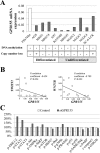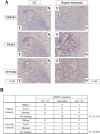GPR155 Serves as a Predictive Biomarker for Hematogenous Metastasis in Patients with Gastric Cancer
- PMID: 28165032
- PMCID: PMC5292715
- DOI: 10.1038/srep42089
GPR155 Serves as a Predictive Biomarker for Hematogenous Metastasis in Patients with Gastric Cancer
Abstract
The prognosis of patients with gastric cancer (GC) with hematogenous metastasis is dismal. Identification of biomarkers specific for hematogenous metastasis is required to develop personalized treatments that improve patients' outcomes. Global expression profiling of GC tissues with synchronous hepatic metastasis without metastasis to the peritoneal cavity or distant lymph nodes was conducted using next-generation sequencing and identified the G protein-coupled receptor 155 (GPR155) as a candidate biomarker. GPR155 transcription was suppressed in GC cell lines compared with a nontumorigenic cell line. DNA methylation of the GPR155 promoter region was not detected, albeit 20% of GC cell lines harbored copy number loss at GPR155 locus. The expression levels of GPR155 mRNA correlated inversely with those of TWIST1 and WNT5B. Inhibition of GPR155 expression increased the levels of p-ERK1/2 and p-STAT1, significantly increased cell proliferation, and increased the invasiveness of a GC cell lines. GPR155 mRNA levels in GC clinical samples correlated with hematogenous metastasis and recurrence. Multivariate analysis revealed that reduced expression of GPR155 mRNA was an independent predictive marker of hematogenous metastasis. GPR155 may represent a biomarker for diagnosing and predicting hematogenous metastasis of GC.
Conflict of interest statement
The authors declare no competing financial interests.
Figures





Similar articles
-
Metastatic pathway-specific transcriptome analysis identifies MFSD4 as a putative tumor suppressor and biomarker for hepatic metastasis in patients with gastric cancer.Oncotarget. 2016 Mar 22;7(12):13667-79. doi: 10.18632/oncotarget.7269. Oncotarget. 2016. PMID: 26872374 Free PMC article.
-
Downregulation of GPR155 as a prognostic factor after curative resection of hepatocellular carcinoma.BMC Cancer. 2017 Sep 1;17(1):610. doi: 10.1186/s12885-017-3629-2. BMC Cancer. 2017. PMID: 28863781 Free PMC article.
-
FAM46C Serves as a Predictor of Hepatic Recurrence in Patients with Resectable Gastric Cancer.Ann Surg Oncol. 2017 Oct;24(11):3438-3445. doi: 10.1245/s10434-016-5636-y. Epub 2016 Oct 21. Ann Surg Oncol. 2017. PMID: 27770343
-
Emerging molecular basis of hematogenous metastasis in gastric cancer.World J Gastroenterol. 2016 Feb 28;22(8):2434-40. doi: 10.3748/wjg.v22.i8.2434. World J Gastroenterol. 2016. PMID: 26937132 Free PMC article. Review.
-
Emerging evidence of the molecular landscape specific for hematogenous metastasis from gastric cancer.World J Gastrointest Oncol. 2018 Jun 15;10(6):124-136. doi: 10.4251/wjgo.v10.i6.124. World J Gastrointest Oncol. 2018. PMID: 29988904 Free PMC article. Review.
Cited by
-
A novel dual-marker expression panel for easy and accurate risk stratification of patients with gastric cancer.Cancer Med. 2018 Jun;7(6):2463-2471. doi: 10.1002/cam4.1522. Epub 2018 May 7. Cancer Med. 2018. PMID: 29733517 Free PMC article.
-
An integrated multigene expression panel to predict long-term survival after curative hepatectomy in patients with hepatocellular carcinoma.Oncotarget. 2017 Aug 19;8(41):71070-71079. doi: 10.18632/oncotarget.20369. eCollection 2017 Sep 19. Oncotarget. 2017. PMID: 29050343 Free PMC article.
-
Expression of cellular retinoic acid binding protein 1 predicts peritoneal recurrence of gastric cancer.Int J Oncol. 2022 Jun;60(6):63. doi: 10.3892/ijo.2022.5353. Epub 2022 Apr 13. Int J Oncol. 2022. PMID: 35417033 Free PMC article.
-
SYT7 acts as a driver of hepatic metastasis formation of gastric cancer cells.Oncogene. 2018 Sep;37(39):5355-5366. doi: 10.1038/s41388-018-0335-8. Epub 2018 Jun 1. Oncogene. 2018. PMID: 29858600
-
Evolution of the Membrane Transport Protein Domain.Int J Mol Sci. 2022 Jul 22;23(15):8094. doi: 10.3390/ijms23158094. Int J Mol Sci. 2022. PMID: 35897663 Free PMC article.
References
-
- Martin-de-Argila C. et al.. Relation between histologic subtypes and location of gastric cancer and Helicobacter pylori. Scand. J. Gastroenterol. 32, 303–307 (1997). - PubMed
Publication types
MeSH terms
Substances
LinkOut - more resources
Full Text Sources
Other Literature Sources
Medical
Molecular Biology Databases
Research Materials
Miscellaneous

